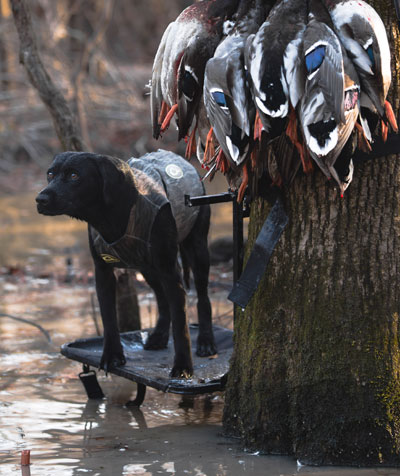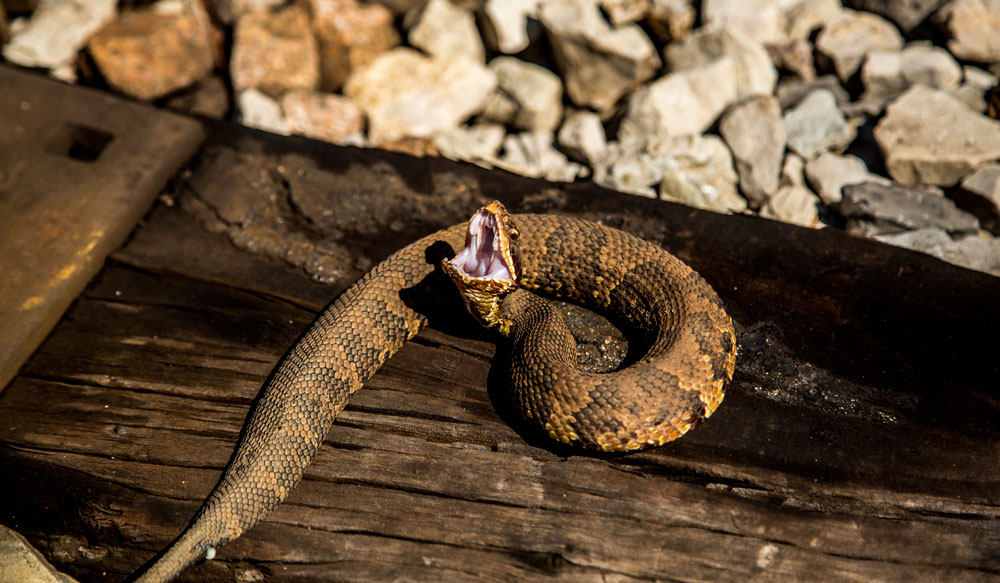Bill Gibson
Here at GameKeeper Kennels we train Labrador Retrievers to be a “Hunter’s Best Friend for Life.” Our dual-purpose retrievers are not only hunting dogs but companions that thrive at home, in the field, or in the house. Our “best friends for life” carry some of the finest bloodlines imported from the United Kingdom and the Republic of Ireland.
All dogs possess the quintessential, and often discussed, “on/off switch.” The switch is on in the field and off in the house. Because of their calm and gentle nature around the house, they soon become an intrinsic part of the family - loved by all. Being an integral part of the family, they hopefully receive the best veterinary care available. Unfortunately, like us, there are health-related issues that can arise from situations both in and around the house and in the field. With hunting season here, there are many potential hazards a hunting dog might encounter that all dog owners should be aware of.
Hunting Beaver Ponds

Duck hunters like to hunt beaver ponds because the water is normally shallow, and even in the absence of food, they provide excellent resting areas for the ducks. But they also present potential hazards for the duck dog.
Everybody likes to see a lab with a “big water entry.” That is when the dog leaps high in the air and lands several feet from the bank with an accompanying big splash that is very impressive to all watching, but very dangerous for the dog. How many times have you been duck hunting on an old slough or beaver run, and when daylight approached, you looked around and saw sharp pointed “beaver stobs” sticking out of the water and even some submerged just under the surface?
The problem is that these beaver stobs can easily pierce a dog’s skin and inflict wounds that run from relatively minor to serious, life-threatening injuries, and in some cases to certain and immediate death. These sharp stakes, whether or not combined with a “big water entry,” present a clear and present danger to all our dogs and are arguably the most dangerous in terms of severity of the wound(s).
A dog doesn’t have to launch high into the air to impale itself on a stob, and just swimming over one of these submerged stakes can result in piercing the skin. As the dog struggles to free itself, it may push deeper (maybe into the chest cavity or abdomen) and can then pierce vital organs or other soft tissue, leading to horrific wounds, infections or death.

Many years ago, I had a friend that had this happen to his dog. His dog was swimming to retrieve a shot duck and all of a sudden, he appeared to be swimming but was actually going nowhere. He had swum upon a beaver stob, and it had pierced the skin on his abdomen and he was hung. Unfortunately for the dog, my friend could not get to him quickly enough and in the struggle to free itself, the dog succumbed to the wound.
While there is no action you can take to be 100-percent certain no harm will come to your dog, you can at least take precautions to minimize the threat. First, you can put a neoprene vest on your dog to increase the level of protection. It’s not 100-percent effective, but it does offer a higher level of protection for your dog.
In addition to the vest, you can build in another “layer of protection” by simply moving to an area that appears to be clear of stobs and then, when a duck goes down, wade out into the water with your dog at heel and then release your dog to make the retrieve. This will effectively eliminate the opportunity for your dog to make the “big water entry” and impale himself.
You should then watch your dog closely and if the dog appears to be swimming, but going nowhere, get to your dog as quickly as possible, ascertain the problem, and if he has impaled himself, rescue him and get him to the nearest veterinarian ASAP.
Water Born Intestinal Parasites
Retrieving in dirty water can expose a dog to Coccidia, Giardia and potentially life-threatening fungal and protozoan infections. Coccidium is normally only a problem with very young dogs, but with age they develop immunity; whereas, Giardia and other intestinal parasites and fungi can affect both young and old dogs.
The most common symptom of these intestinal parasites is diarrhea, most of the time filling the air with a very putrid odor. Although diarrhea can be caused by a myriad of other factors, if your dog has been exposed to stagnant pond water and has diarrhea, take him to a veterinarian for a fecal flotation test and/or other test deemed appropriate by the vet and then treat him/her according to your veterinarian’s instructions.
Hypothermia

speeds up the process. A neoprene vest is a great
investment. It helps protect from sharp objects, aids in
retaining body heat and helps with floatation when
swimming. Also make sure your canine has a spot where
they can rest completely out of the water.
How many times have you heard of someone losing or almost losing their duck dog to hypothermia? What was the causative factor leading to this condition? Could it have been the warning signs were ignored or simply a case of lack of awareness?
While there are many reasons for the onset of hypothermia, the principal reason is simply not knowing the causes and symptoms and unnecessarily placing the dog at risk. Allowing the dog to wade or swim a long distance to the blind, and then sitting the dog in even an inch or two of cold water quickly escalates the onset of hypothermia. You should never take your dog duck hunting in a place where he/she cannot get completely out of the water. Even standing in an inch or two of frigid water can lead to hypothermia and possible frostbite of the feet and toes, the tips of the ears, the end of the tail and the scrotum.
By definition, hypothermia is low body temperature caused by exposure to extreme cold for a period of time. There are three levels of hypothermia: mild, moderate and severe. Mild is associated with a body temperature of 90 to 99 degrees Fahrenheit. Moderate is defined as a body temperature of 82 to 90 degrees Fahrenheit. Severe is defined as a body temperature of less than 82 degrees Fahrenheit. The symptoms vary with the level of hypothermia.
Low level symptoms include weakness, shivering, and becoming lethargic. More advanced symptoms include muscle stiffness, lack of mental acuity, and shallow breathing.
As an example, one day, many years ago, on a particularly cold day in January, after an early morning hunt, we noticed that my lab was shivering and decided to call it a day. I watched my lab as he swam a hundred yards or so through flooded timber from the duck blind to get to the edge of the beaver slough. One minute he appeared to be fine and the next minute he was grasping a tree with his front legs because he had become hypothermic and his muscles were stiffening up; he could no longer swim. I almost had to pry his legs from around the small tree. My buddy immediately put him in the Hustler, transported him to the truck, turned the heater on high and warmed him up. He was fine, but he gave us a good scare.

The point to remember in all of this is do not expose your “best friend” to a situation that could result in hypothermia and if you observe the first sign (shivering), it is time to take action. Get the dog out of the water and warmed up. This may mean abandoning the hunt, carrying your dog to the truck and running the heater, but it must be done.
Heat Stroke
In the South, we normally have some extremely hot, sunny days, especially during the early dove season, the early fall teal season, and the early resident goose season. During these early seasons your lab can easily become overheated and if the situation is not properly dealt with, the end result can be a heat stroke that can be debilitating for the remainder of his life or even result in death.
How do you know that your retriever is overheating? One easy and surefire way is to keep a close watch on the tip of his tongue. If it is beginning to turn red, it is time for him to take a break and possibly quit for the day.
Many mistakenly believe that if their dog begins to overheat the best solution is to put him in a pond or lake to take a swim and cool off. While this tactic is better than nothing, you aren’t going to gain much in terms of relief because the surface temperature of the water is about the same as the ambient temperature of the air. So what can you do?
From a prevention standpoint, don’t put your dog in a situation that would expose him to a possible heat stroke by limiting his retrieves, keeping him in the shade, and keeping him hydrated with a good supply of cool water for him to drink. Again, keep a close watch on your dog, looking for any signs of overheating.
Snake Bites
There are basically four poisonous snakes that live in the U.S. The three most likely to be encountered by a dog are rattlesnakes, cottonmouths, copperheads, and coral snakes. Probably, the most frequently encountered in descending order are the copperhead, the cottonmouth and the rattlesnake. Over many years of training and hunting with my dogs, I have had two snake strikes on two different labs. One was bitten by a rattler and one by a copperhead. Both were immediately taken to my vet and luckily both survived. One had no long-term health issues, but the one struck by the rattlesnake had long-term health issues that eventually led to his demise.
There is a rattlesnake vaccine on the market that is made from the venom of the western rattlesnake, and it offers very good but limited protection against a rattlesnake bite by reducing the severity of the dog’s reaction to the bite. This vaccine also provides some protection against copperhead bites, but offers little or no protection against cottonmouth bites. Regardless, I highly recommend inoculating your dog, because reducing and delaying the severity of the dog’s reaction to the bite buys you time to get your dog to your vehicle and transported to the nearest vet for treatment.

Symptoms of a poisonous snakebite include fang marks at the bite site along with swelling, severe pain, panting and/or drooling. Also, depending on the quantity of venom injected into the dog by the snake, your dog may become lethargic to the point of collapse, experience seizures or have respiratory problems.
If you did not actually see the snake strike your dog, visually scan the immediate area in an attempt to identify the snake. Then, the best option would be to carry your dog to your vehicle, or if unable to carry, slowly walk your dog to your vehicle. By walking the dog slowly rather than running, you will slow the spread of venom through the dog’s body. LASTLY, GET YOUR DOG TO THE NEAREST VET AS SOON AS POSSIBLE.
A non-poisonous snakebite can also lead to infections that may result in health issues for your dog. So even if your dog is bitten by a non-poisonous snake, it is best to take him to the vet for evaluation and possible antibiotic treatment.



























